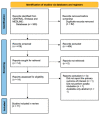Videolaryngoscopy versus Fiberoptic Bronchoscopy for Awake Tracheal Intubation: A Systematic Review and Meta-Analysis of Randomized Controlled Trials
- PMID: 38892899
- PMCID: PMC11173084
- DOI: 10.3390/jcm13113186
Videolaryngoscopy versus Fiberoptic Bronchoscopy for Awake Tracheal Intubation: A Systematic Review and Meta-Analysis of Randomized Controlled Trials
Abstract
Background: In recent years, videolaryngoscopy has increasingly been utilized as an alternative to fiberoptic bronchoscopy in awake intubation. Nonetheless, it remains uncertain whether videolaryngoscopy represents a viable substitute for fiberoptic bronchoscopy. We conducted this systematic review with a meta-analysis to compare videolaryngoscopy and fiberoptic bronchoscopy for awake intubation. Methods: We systematically searched for all randomized controlled trials (RCTs) comparing videolaryngoscopy and fiberoptic bronchoscopy for awake intubation. The Cochrane Central Register of Controlled Trials (CENTRAL), Embase, and MEDLINE were systematically queried through August 2023. Our primary outcome measure was the duration of intubation. Secondary outcomes encompassed the rate of successful intubation on the initial attempt, failed intubation, patient-reported satisfaction, and any complications or adverse events potentially stemming from the intubation procedure. The Cochrane Risk of Bias Tool for RCTs was employed to evaluate all studies for evidence of bias. The GRADE approach was utilized to gauge the certainty of the evidence. Results: Eleven trials involving 873 patients were ultimately included in our review for data extraction. Meta-analysis demonstrated that videolaryngoscopy decreased the duration of intubation compared to fiberoptic bronchoscopy (SMD -1.9671 [95% CI: -2.7794 to -1.1548] p < 0.0001), a finding corroborated in subgroup analysis by the type of videolaryngoscope (SMD -2.5027 [95% CI: -4.8733 to -0.1322] p = 0.0385). Additionally, videolaryngoscopy marginally lowered the risk of experiencing a saturation below 90% during the procedure (RR -0.7040 [95% CI: -1.4038 to -0.0043] p = 0.0486). No statistically significant disparities were observed between the two techniques in terms of failed intubation, initial successful intubation attempt, or sore throat/hoarseness. With regard to patient-reported satisfaction, a pooled analysis was precluded due to the variability in evaluation methods employed across the trials to assess this outcome. Lastly, trial sequential analysis (TSA) conducted for intubation time (primary outcome) affirmed the conclusiveness of this evidence; TSA performed for secondary outcomes failed to yield conclusive evidence, indicating the necessity for further trials. Conclusions: Videolaryngoscopy for awake tracheal intubation diminishes intubation time and the risk of experiencing a saturation below 90% compared to fiberoptic bronchoscopy.
Keywords: airway management; awake intubation; fiberoptic bronchoscopy; meta-analysis; trial sequential analysis; videolaryngoscopy.
Conflict of interest statement
The authors declare no conflicts of interest.
Figures










Similar articles
-
Videolaryngoscopy vs. fibreoptic bronchoscopy for awake tracheal intubation: a systematic review and meta-analysis.Anaesthesia. 2018 Sep;73(9):1151-1161. doi: 10.1111/anae.14299. Epub 2018 Apr 17. Anaesthesia. 2018. PMID: 29687891
-
Videolaryngoscopy versus fiberoptic bronchoscope for awake intubation - a systematic review and meta-analysis of randomized controlled trials.Ther Clin Risk Manag. 2018 Oct 15;14:1955-1963. doi: 10.2147/TCRM.S172783. eCollection 2018. Ther Clin Risk Manag. 2018. PMID: 30410341 Free PMC article.
-
Tracheal intubation in patients at risk for cervical spinal cord injury: A systematic review.Acta Anaesthesiol Scand. 2020 Apr;64(4):443-454. doi: 10.1111/aas.13532. Epub 2019 Dec 27. Acta Anaesthesiol Scand. 2020. PMID: 31837227
-
Videolaryngoscopy versus direct laryngoscopy for tracheal intubation in neonates.Cochrane Database Syst Rev. 2023 May 12;5(5):CD009975. doi: 10.1002/14651858.CD009975.pub4. Cochrane Database Syst Rev. 2023. PMID: 37171122 Free PMC article. Review.
-
Awake videolaryngoscopy versus fiberoptic bronchoscopy.Curr Opin Anaesthesiol. 2019 Dec;32(6):764-768. doi: 10.1097/ACO.0000000000000771. Curr Opin Anaesthesiol. 2019. PMID: 31356364 Review.
Cited by
-
Tracheostomy Practice in the Italian Intensive Care Units: A Point-Prevalence Survey.Medicina (Kaunas). 2025 Jan 7;61(1):87. doi: 10.3390/medicina61010087. Medicina (Kaunas). 2025. PMID: 39859070 Free PMC article.
-
The conclusiveness of trial sequential analysis varies with estimation of between-study variance: a case study.BMC Med Res Methodol. 2025 Apr 17;25(1):101. doi: 10.1186/s12874-025-02545-x. BMC Med Res Methodol. 2025. PMID: 40247168 Free PMC article.
-
Hyperangulated videolaryngoscope for difficult airway management: a protocol for a systematic review with meta-analysis and trial sequential analysis.BMJ Open. 2025 Jun 23;15(6):e098508. doi: 10.1136/bmjopen-2024-098508. BMJ Open. 2025. PMID: 40550711 Free PMC article.
-
Videolaryngoscopy is associated with a lower rate of double-lumen endotracheal tube malposition in thoracic surgery procedures, retrospective single-center study.J Cardiothorac Surg. 2025 Jan 4;20(1):11. doi: 10.1186/s13019-024-03239-z. J Cardiothorac Surg. 2025. PMID: 39755656 Free PMC article.
-
Successful awake intubation using Airtraq® in a low-resource setting for a patient with severe post-burn contractures.BMC Anesthesiol. 2025 Jan 7;25(1):12. doi: 10.1186/s12871-024-02887-x. BMC Anesthesiol. 2025. PMID: 39773177 Free PMC article.
References
-
- Apfelbaum J.L., Hagberg C.A., Connis R.T., Abdelmalak B.B., Agarkar M., Dutton R.P., Fiadjoe J.E., Greif R., Klock P.A., Mercier D., et al. 2022 American Society of Anesthesiologists Practice Guidelines for Management of the Difficult Airway. Anesthesiology. 2022;136:31–81. doi: 10.1097/ALN.0000000000004002. - DOI - PubMed
Publication types
LinkOut - more resources
Full Text Sources
Research Materials

